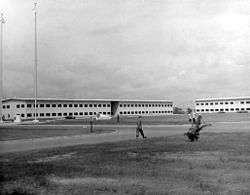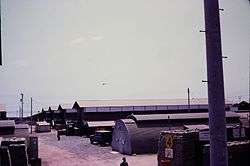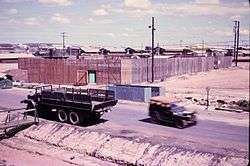Long Binh Post
| Long Binh Post | |
|---|---|
| Long Bình ward | |
| Coordinates | 10°56′26″N 106°54′03″E / 10.940518°N 106.900892°E |
| Type | Army Base |
| Site information | |
| Condition | Seized in April 1975 by the PAVN, now an industrial/techno-park |
| Site history | |
| Built | circa 1965 |
| In use | 1965-1975 |
| Battles/wars |
Vietnam War |
| Garrison information | |
| Occupants |
United States Army Vietnam (USARV) 1st Logistical Command II Field Force 1st Aviation Brigade 18th Military Police Brigade 199th Light Infantry Brigade 44th Medical Brigade 24th Evacuation Hospital 93rd Evacuation Hospital |
Long Binh Post is a former U.S. Army base located in Long Bình ward between Biên Hòa and Saigon, Vietnam.
History


.jpg)

Long Binh Post was located on the east of Đồng Nai river, 20 km northeast from Saigon (now called Hồ Chí Minh City).[2] The base functioned as a U.S. Army base, logistics center, and major command headquarters for United States Army Vietnam (USARV). Long Binh Post was 7 km southeast from Biên Hòa Air Base.[2]:301 Long Binh Post was also unofficially known as "Long Binh Junction, influenced by the widely used initials of then-President Lyndon B. Johnson.
By mid-1967, United States Army, Vietnam (USARV), 1st Logistical Command and many other Army units dispersed in Saigon were moved to Long Binh Post to resolve centralization, security, and troop billeting issues. Long Binh Post was a sprawling logistics facility and the largest U.S. Army base in Vietnam, with a peak of 60,000 personnel in 1969.[3] The base was the target of several attacks, especially during Tet in 1968 as well as 1969.[4]
Major units
The II Field Force, 1st Aviation Brigade, 18th Military Police Brigade, 199th Light Infantry Brigade, 44th Medical Brigade and the 93rd and 24th Evacuation Hospitals were located on Long Binh Post. Logistics was provided by the 266th Supply and Service Battalion which provided graves registration; clothing and equipment; petroleum, oil, and lubricants (POL); and construction supplies for the III Corp Area in Vietnam. Another unit was the 90th Replacement Battalion, a first stop for newly arrived U.S. Army enlisted personnel, who were then permanently assigned to other units in Vietnam.[5] Long Binh Post included the Long Binh Stockade, a U.S. Army prison, from 1966 to the 1970s also known unofficially as "LBJ" or "Long Binh Jail"[2]:5–301
The Việt Cộng attacked the Long Binh ammunition supply point on 4 February 1967 destroying at least 15,000 high explosive 155 mm artillery projectiles.[6]
Post facilities
Long Binh Post had dental clinics, large restaurants, snack bars, A Special Services Crafts Shop, that provided crafts, photo lab, wood shop, lapidary, leather crafting and silver/gold casting classes. Post Exchanges, swimming pools, basketball and tennis courts, a golf driving range, University of Maryland extension classes, a bowling alley, many nightclubs (officer, NCO, enlisted) with live music, a Chase Manhattan Bank branch, laundry services, and a massage parlor. The base and its facilities were handed over to the South Vietnamese army on 11 November 1972.[1]
Post Vietnam War
The area formerly occupied by the Long Binh post is now Long Bình ward, which as of 2008 is largely given over to industrial use, known as Long Binh Techno Park and a shopping complex.
References
- 1 2 Long Binh base turned over to South Vietnam — History.com This Day in History — 11/11/1972
- 1 2 3 Kelley, Michael P. (2002). Where We Were in Vietnam. Hellgate Press, Central Point, Oregon. p. 300. ISBN 978-1-55571-625-7.
- ↑ LONG BINH - Largest American Base in Vietnam - a photo on Flickriver
- ↑ Pike, Thomas (2016). Operations & Intelligence, III Corps Reporting: Tet 1969. pp. 104–7. ISBN 9781534799035.
- ↑ Stanton, Shelby (1987). Vietnam Order of Battle. Galahad Books, New York, New York. p. 197. ISBN 9780671081591.
- ↑ EOD in Vietnam 1966-1967, Photo Album
Further reading
- Edwin E. Moïse. The A to Z of the Vietnam War. Lanham, MD: Scarecrow Press (Rowman & Littlefield), 2005
External links
- "The War: Riot at the LBJ". time.com. 6 September 1968. Retrieved 2014-06-13.
- "The LongBinh Techno Park". loteco.com.vn. Retrieved 2014-06-13.